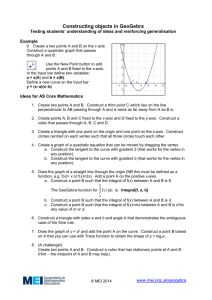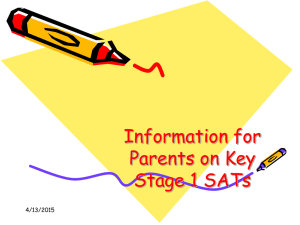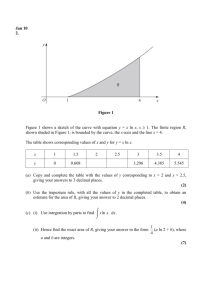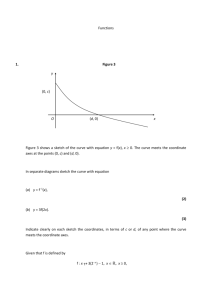Review Questions
advertisement
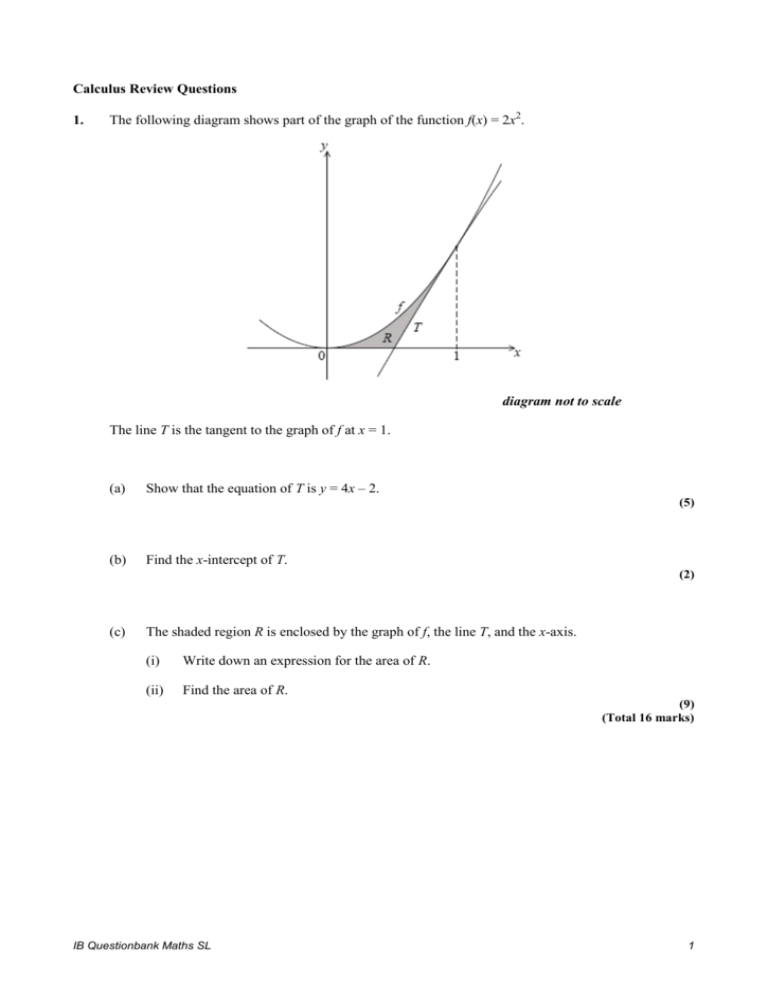
Calculus Review Questions 1. The following diagram shows part of the graph of the function f(x) = 2x2. diagram not to scale The line T is the tangent to the graph of f at x = 1. (a) Show that the equation of T is y = 4x – 2. (5) (b) Find the x-intercept of T. (2) (c) The shaded region R is enclosed by the graph of f, the line T, and the x-axis. (i) Write down an expression for the area of R. (ii) Find the area of R. (9) (Total 16 marks) IB Questionbank Maths SL 1 2. Consider the function f with second derivative f′′(x) = 3x – 1. The graph of f has a minimum point 4 358 at A(2, 4) and a maximum point at B , . 3 27 (a) Use the second derivative to justify that B is a maximum. (3) (b) Given that f′ = 3 2 x – x + p, show that p = –4. 2 (4) (c) Find f(x). (7) (Total 14 marks) 3. Let f(x) = x3 – 4x + 1. (a) Expand (x + h)3. (2) (b) Use the formula f′(x) = lim h 0 f ( x h) f ( x) to show that the derivative of f(x) is 3x2 – 4. h (4) (c) The tangent to the curve of f at the point P(1, –2) is parallel to the tangent at a point Q. Find the coordinates of Q. (4) (d) The graph of f is decreasing for p < x < q. Find the value of p and of q. (3) (e) Write down the range of values for the gradient of f. (2) (Total 15 marks) IB Questionbank Maths SL 2 4. Let f(x) = 1 3 x x 2 3x . Part of the graph of f is shown below. 3 There is a maximum point at A and a minimum point at B(3, –9). (a) Find the coordinates of A. (8) (b) Write down the coordinates of (i) the image of B after reflection in the y-axis; (ii) 2 the image of B after translation by the vector ; 5 (iii) the image of B after reflection in the x-axis followed by a horizontal stretch with 1 scale factor . 2 (6) (Total 14 marks) IB Questionbank Maths SL 3 5. Let f(x) = Aekx + 3. Part of the graph of f is shown below. The y-intercept is at (0, 13). (a) Show that A =10. (2) (b) Given that f(15) = 3.49 (correct to 3 significant figures), find the value of k. (3) (c) (i) Using your value of k, find f′(x). (ii) Hence, explain why f is a decreasing function. (iii) Write down the equation of the horizontal asymptote of the graph f. (5) Let g(x) = –x2 + 12x – 24. (d) Find the area enclosed by the graphs of f and g. (6) (Total 16 marks) IB Questionbank Maths SL 4 6. Let f(x) = x3. The following diagram shows part of the graph of f. diagram not to scale The point P (a, f(a)), where a > 0, lies on the graph of f. The tangent at P crosses the x-axis at the 2 point Q , 0 . This tangent intersects the graph of f at the point R(–2, –8). 3 (a) (i) Show that the gradient of [PQ] is (ii) Find f′(a). (iii) Hence show that a = 1. a3 2 a 3 . (7) Continues... IB Questionbank Maths SL 5 ...continued The equation of the tangent at P is y = 3x – 2. Let T be the region enclosed by the graph of f, the tangent [PR] and the line x = k, between x = –2 and x = k where –2 < k < 1. This is shown in the diagram below. diagram not to scale (b) Given that the area of T is 2k + 4, show that k satisfies the equation k4 – 6k2 + 8 = 0. (9) (Total 16 marks) IB Questionbank Maths SL 6 7. Let f(x) = (a) x . Line L is the normal to the graph of f at the point (4, 2). Show that the equation of L is y = –4x + 18. (4) (b) Point A is the x-intercept of L. Find the x-coordinate of A. (2) In the diagram below, the shaded region R is bounded by the x-axis, the graph of f and the line L. (c) Find an expression for the area of R. (3) (d) The region R is rotated 360° about the x-axis. Find the volume of the solid formed, giving your answer in terms of π. (8) (Total 17 marks) IB Questionbank Maths SL 7 8. Let f : x sin3 x. (a) (i) Write down the range of the function f. (ii) Consider f (x) =1, 0 x 2. Write down the number of solutions to this equation. Justify your answer. (5) (b) Find f ′ (x), giving your answer in the form a sinp x cosq x where a, p, q . (2) 1 (c) Let g (x) = 3 sin x (cos x) 2 for 0 x π . Find the volume generated when the curve of 2 g is revolved through 2 about the x-axis. (7) (Total 14 marks) 9. The acceleration, a m s–2, of a particle at time t seconds is given by a = 2t + cost. (a) Find the acceleration of the particle at t = 0. (2) (b) Find the velocity, v, at time t, given that the initial velocity of the particle is 2 m s–1. (5) (c) Find 3 vdt , giving your answer in the form p – q cos 3. 0 (7) (d) What information does the answer to part (c) give about the motion of the particle? (2) (Total 16 marks) IB Questionbank Maths SL 8 10. Let f (x) = ex (1 – x2). (a) Show that f ′ (x) = ex (1 – 2x – x2). (3) Part of the graph of y = f (x), for – 6 x 2, is shown below. The x-coordinates of the local minimum and maximum points are r and s respectively. (b) Write down the equation of the horizontal asymptote. (1) (c) Write down the value of r and of s. (4) (d) Let L be the normal to the curve of f at P(0, 1). Show that L has equation x + y = 1. (4) (e) Let R be the region enclosed by the curve y = f (x) and the line L. (i) Find an expression for the area of R. (ii) Calculate the area of R. (5) (Total 17 marks) IB Questionbank Maths SL 9 11. The function f (x) is defined as f (x) = 3 + (a) 5 1 ,x . 2 2x 5 Sketch the curve of f for −5 x 5, showing the asymptotes. (3) (b) Using your sketch, write down (i) the equation of each asymptote; (ii) the value of the x-intercept; (iii) the value of the y-intercept. (4) (c) The region enclosed by the curve of f, the x-axis, and the lines x = 3 and x = a, is revolved through 360 about the x-axis. Let V be the volume of the solid formed. 1 9 6 2 x 5 2 x 52 dx. (i) Find (ii) 28 Hence, given that V = π 3 ln 3 , find the value of a. 3 (10) (Total 17 marks) IB Questionbank Maths SL 10 12. Let f (x) = p 3x , where p, q x q2 + 2 . Part of the graph of f, including the asymptotes, is shown below. (a) The equations of the asymptotes are x =1, x = −1, y = 2. Write down the value of (i) p; (ii) q. (2) (b) Let R be the region bounded by the graph of f, the x-axis, and the y-axis. (i) Find the negative x-intercept of f. (ii) Hence find the volume obtained when R is revolved through 360 about the x-axis. (7) (c) . 3 x 2 1 (i) Show that f ′ (x) = (ii) Hence, show that there are no maximum or minimum points on the graph of f. x 2 1 2 (8) (d) Let g (x) = f ′ (x). Let A be the area of the region enclosed by the graph of g and the x-axis, between x = 0 and x = a, where a 0. Given that A = 2, find the value of a. (7) (Total 24 marks) IB Questionbank Maths SL 11 13. 5 1 , x Consider the function f (x) e(2x–1) + . 2 2 x 1 (a) Sketch the curve of f for −2 x 2, including any asymptotes. (3) (b) (i) Write down the equation of the vertical asymptote of f. (ii) Write down which one of the following expressions does not represent an area between the curve of f and the x-axis. 2 2 1 0 (iii) f (x)dx f (x)dx Justify your answer. (3) (c) The region between the curve and the x-axis between x = 1 and x = 1.5 is rotated through 360 about the x-axis. Let V be the volume formed. (i) Write down an expression to represent V. (ii) Hence write down the value of V. (4) (d) Find f ′ (x). (4) (e) (i) Write down the value of x at the minimum point on the curve of f. (ii) The equation f (x) = k has no solutions for p k q. Write down the value of p and of q. (3) (Total 17 marks) IB Questionbank Maths SL 12 14. Let f (x) = – 3 2 x + x + 4. 4 (a) (i) Write down f ′ (x). (ii) Find the equation of the normal to the curve of f at (2, 3). (iii) This normal intersects the curve of f at (2, 3) and at one other point P. Find the x-coordinate of P. (9) Part of the graph of f is given below. (b) Let R be the region under the curve of f from x = −1 to x = 2. (i) Write down an expression for the area of R. (ii) Calculate this area. (iii) The region R is revolved through 360 about the x-axis. Write down an expression for the volume of the solid formed. (6) (c) Find k 1 f ( x) dx, giving your answer in terms of k. (6) (Total 21 marks) IB Questionbank Maths SL 13 x 15. The diagram shows part of the graph of y = e 2 . y x y = e2 P ln2 (a) x Find the coordinates of the point P, where the graph meets the y-axis. (2) The shaded region between the graph and the x-axis, bounded by x = 0 and x = ln 2, is rotated through 360° about the x-axis. (b) Write down an integral which represents the volume of the solid obtained. (4) (c) Show that this volume is . (5) (Total 11 marks) IB Questionbank Maths SL 14
